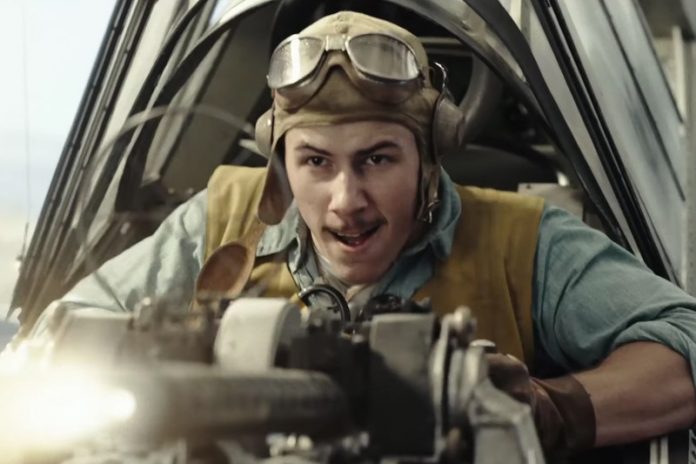ARTNEWSPRESS: At least “Pearl Harbor” had panache. The best thing you can say about Roland Emmerich’s “Midway” — a bland as hell, Walmart-ready, torpedo-by-numbers retelling of World War II’s most decisive naval battle — is that it doesn’t completely dehumanize the Japanese characters. In fact, Admiral Yamamoto and his men are almost (but not quite) three-dimensional compared to the human cartoons on the American side, a bunch of generic lugs who talk like they’re from Brooklyn, act like they want just wandered off the set of “Anchors Aweigh,” and feel like real people in name only.
It’s a shame, because this movie sometimes evinces a genuine respect for men on both sides of the fight, and for the courage required to die for a country whose faraway leaders will never make that sacrifice; “Midway” is nothing if not an aggressively basic reminder that America is only as strong as the people who are willing to protect it with their lives. Alas, those people deserve a far better tribute than what Emmerich has scraped together for them here.
‘Noelle’ Review: Disney+’s Anna Kendrick Holiday Comedy Is a Sloppy Hallmark Channel Ripoff
Military Times Editor Writes Scathing Takedown of Roland Emmerich’s ‘Midway’
Written by Wes Tooke, whose screenplay navigates the murky waters between December 7, 1941 and June 7, 1942 with all the wit and elegance of a Wikipedia page, “Midway” dutifully charts a course through the history books. But if the film’s story is steered by a hard-nosed focus on the large and small of what actually happened, the way Emmerich tells it feels more informed by WWII movies than it does by the war itself.
It’s not just that John Ford (Geoffrey Blake) shows up as a minor character in the middle of the action, or that Admiral Yamamoto (a lucidly tragic Toyokawa Etsushi) quotes a line from “Tora! Tora! Tora!” as though it were something the man really said; even the most straightforward retellings have to “print the legend” from time to time. But “Midway” doesn’t merely indulge in certain genre clichés so much as it seems hellbent on memorializing them. That starts with reckless fighter pilot Richard Halsey Best, a brash Navy showboat who the movie reduces to such a caricature of a war hero that he makes Steve Rogers seem like a real person by comparison.
Played by woefully miscast “Game of Thrones” actor Ed Skrein, Best is the kind of square-jawed pain in the ass who will either win the war or get his entire unit killed. He hates orders, loves his friends, and flies into every blaze of enemy gunfire safe in the knowledge that his wife is staring out the kitchen window of their house in Honolulu, her eyes locked on the horizon and her hair crimped to perfection (Mandy Moore tries in vain to elevate the most thankless role of a movie that doesn’t have any other kind, but — no disrespect to a bonafide American hero — she might deserve the Medal of Honor for repeatedly having to say that she loves “Dick Best” with a straight face).
The rest of the scattered ensemble is filled out with an array of standard-issue archetypes, and even the best actors can’t help but feel like they’re cos-playing “Band of Brothers.” On the American side of things, Patrick Wilson comes closest to acquitting himself as the wistfully brilliant codebreaker Edwin Layton; a prologue scene in which he and Yamamoto discuss their powerlessness to stop the coming war strikes a nuanced, bittersweet tone that the rest of the film never really bothers to look for again.
Elsewhere, Woody Harrelson slumbers through his role as Admiral Chester Nimitz as if trying not to disturb the awful gray wig on his head, while Dennis Quaid spends the whole film scratching at a bad case of shingles in a part that a more pointed movie would have cut. Aaron Eckhart clenches his way through a cameo as Colonel Jimmy Doolittle, whose critical air raid into Tokyo is never given proper context; a needless sequence where he crashlands into rural China is shoehorned in to appease financiers like Shanghai Ruyi Entertainment, while a tossed off title card about the 235,000 Chinese civilians who were murdered for helping Doolittle adds a glib aftertaste to its clumsy inclusion.
Nick Jonas, Darren Criss, and Keean Johnson each fill out their historically accurate roles with requisite hotness, and the great Asano Tadanobu barks his way through his limited screen time as Rear Admiral Yamaguchi Tamon. The lack of strong characters exposes the deficiencies of a herky jerky script that clearly explicates what is happening, but often at the expense of why (and the narrative momentum that might come from answering that question).
Of course, Emmerich (“Independence Day,” “The Day After Tomorrow”) has managed to shoot his way through hackneyed scripts before, but anyone hoping to see the attack on Pearl Harbor awaken a sleeping giant will be disappointed to find that the “master of disaster” is still asleep at the wheel. Emmerich forged — and then flourished during — the mid-’90s renaissance of special effects-driven summer blockbusters because he understood how digital tools could tell analog stories of human survival on a dramatic new scale. When the technology became more prevalent and audiences developed an intolerance to computer-generated spectacle, Emmerich became a victim of his own destructive vision, and was eventually cornered into making hollow cataclysms like “2012” and “Independence Day: Resurgence” that were absent any human element whatsoever.
When Emmerich signed on to direct a movie that boasts a battle worthy of his particular skill set — but not a brand capable of supporting his usual budget — it seemed like he might be getting back to basics. That’s not quite how things turned out. While “Midway” exudes a palpable degree of period detail (which it deploys in the service of some truly hair-raising aerial combat sequences), the film is hamstrung by second-rate special effects from the start. Inside the cockpit, “Midway” can be an immersive experience. Outside, however, it often feels like Emmerich is going overboard with the CGI to obscure how cruddy it all looks up close.
Beginning with a groan-worthy Pearl Harbor sequence that shows the infamous attack through the eyes of a strapping blond sailor and the vaguely pubescent new recruit he’s determined to protect from plumes of badly computerized fire, “Midway” is a galling example of how PG-13 war movies will often chaff the screen with empty spectacle in order to obscure the horrors that are endemic to their genre (“Dunkirk” was the exception that proves the rule). Such an uncomplicated rendering of what led to the Battle of Midway fails to square with the anesthetization of Emmerich’s approach.
www.indiewire.com
David Ehrlich
























